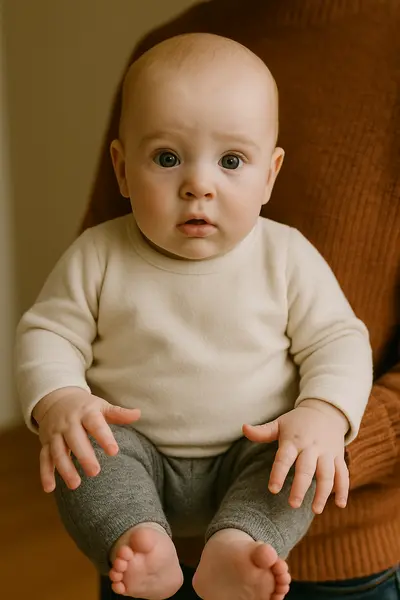- Why Does My Baby Have Cold Hands and Feet?
- Common Causes of Cold Hands and Feet in Babies
- When Should You Be Concerned?
- How to Warm Your Baby’s Hands and Feet
- Medical Attention: When and Why
- Summary and Reassurance
- Final Thoughts: Trust Your Parental Intuition
Why Does My Baby Have Cold Hands and Feet?
Many parents find themselves concerned, asking, “Why does my baby have cold hands and feet?” It’s a common observation, especially during naps or nighttime. Understanding this phenomenon is essential for new caregivers. A baby’s unique physiology and immature circulation often explain this cold extremity mystery. Therefore, let’s explore the possible causes, when to be concerned, and how to ensure your baby stays comfortable.
Common Causes of Cold Hands and Feet in Babies
Immature Circulatory System
Babies have underdeveloped circulation, which means blood is prioritized for vital organs like the brain and heart. Consequently, blood flow to the hands and feet is reduced, making them feel cooler. This is a completely natural response during early development.
Temperature Regulation Challenges
Babies can’t regulate their body temperature as efficiently as adults. Their thermoregulation system is still maturing, so their extremities often reflect environmental temperature changes. As a result, the hands and feet act like radiators, losing or retaining heat more easily.
Acrocyanosis
This is a common and benign condition in newborns. It causes bluish discoloration in the hands and feet due to reduced oxygen delivery. Fortunately, it usually resolves on its own within hours or days after birth.
Fever Response
Ironically, cold hands and feet can sometimes occur with a fever. When a baby’s core temperature rises, blood may be redirected to internal organs, pulling it away from the extremities. Thus, extremities may feel colder even though the body is overheating.
Lack of Activity
Infants spend a lot of time resting or sleeping. Because of this, decreased movement leads to reduced circulation in the limbs. Eventually, as babies grow and move more, this issue naturally improves.
When Should You Be Concerned?
Signs of Poor Circulation
Cold hands and feet accompanied by blue lips, mottled skin, or unusual sleepiness may signal a more serious circulatory or respiratory issue. In such situations, contact a healthcare provider immediately.
Associated Health Conditions
Chronic conditions like hypothyroidism, Raynaud’s syndrome, anemia, or diabetes can impair circulation. Even though these are rare in babies, it’s important to be aware if these conditions run in your family.
Cold Hypersensitivity (CHHF)
Some studies have linked cold hypersensitivity in the extremities to certain chronic conditions, though these associations are more relevant in older individuals. Nevertheless, it shows the importance of paying attention to persistent symptoms.
How to Warm Your Baby’s Hands and Feet
Add Appropriate Layers
Dress your baby in one more layer than you would wear. Use mittens, socks, and footed pajamas in colder environments. Indeed, these simple additions can make a big difference.
Use a Warm Environment
Ensure the room temperature stays between 68–72°F (20–22°C). Avoid overheating, as this can increase the risk of SIDS (Sudden Infant Death Syndrome). In this case, balance is key.
Skin-to-Skin Contact (Kangaroo Care)
Holding your baby against your chest allows your body heat to regulate theirs. This technique, often used in neonatal care, is both comforting and effective. Moreover, it strengthens bonding.
Encourage Gentle Movement
Tummy time and gentle play stimulate blood flow to the limbs, helping warm little hands and feet naturally. Over time, this helps build stronger circulation.
Medical Attention: When and Why
Persistent Blue Color
If your baby’s extremities remain blue and cool even in warm environments, consult a doctor to rule out circulation issues. Timely intervention is crucial in such cases.
Signs of Illness
Be on the lookout for other symptoms such as lethargy, poor feeding, pale or yellowish skin, or irregular breathing. These warning signs could indicate infections or other medical concerns.
When to Seek Help Urgently
- Cold limbs combined with breathing difficulty
- Blue lips or tongue
- Weak pulse or limp body
- No improvement after warming up
Summary and Reassurance
So, why does my baby have cold hands and feet? For most infants, it’s due to normal blood distribution and an immature thermoregulation system. Eventually, as your baby grows, their circulation improves, and you’ll notice warmer hands and feet more consistently.
Stay calm, stay observant, and remember: most of the time, cold little hands are nothing to worry about. However, trust your instincts—if something feels off, don’t hesitate to reach out to your pediatrician.
Final Thoughts: Trust Your Parental Intuition
Every baby is unique. Understanding your baby’s cues, from cold hands to changes in feeding or mood, helps you respond with confidence. With patience and observation, recognizing what’s normal—and what’s not—will become second nature.
The following post may interest you
Why Does My Baby Rub Their Ears?
Why Does My Baby Spit Up After Every Feeding?
Sources
Responses of the hands and feet to cold exposure
https://www.tandfonline.com/doi/abs/10.1080/23328940.2015.1008890
The roles of hands and feet in temperature regulation in hot and cold environments
https://ro.uow.edu.au/ndownloader/files/50431740
RESEARCH ARTICLE Open Access The association between cold hypersensitivity in the hands and feet and chronic disease: results of a multicentre study

